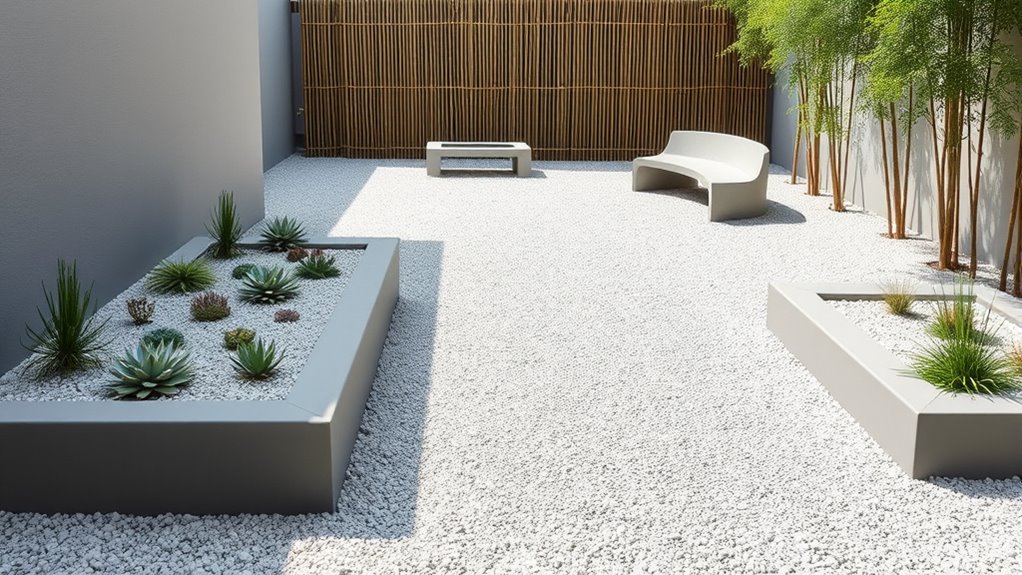To start a minimalist garden, first define your purpose, whether it’s for relaxation or growing plants, and choose a style that fits your needs. Opt for a simple color palette with greens, whites, and earth tones, and select a few plant types that thrive in your space. Design with clean lines, geometric layouts, and natural materials like stone or wood. Keep decorations minimal, and maintain your garden regularly to keep it serene and balanced. If you explore further, you’ll find even more ways to create an elegant, tranquil outdoor space.
Key Takeaways
- Define your garden’s purpose and select a simple, functional layout with clean lines.
- Choose a limited, cohesive color palette and low-maintenance plants suited to your environment.
- Incorporate natural materials like stone and wood, and create geometric, straightforward pathways.
- Keep decorations minimal, focusing on meaningful ornaments and strategic lighting for subtle accents.
- Regularly prune and adapt your garden to maintain its minimalist aesthetic and promote healthy growth.
Define Your Garden’s Purpose and Style
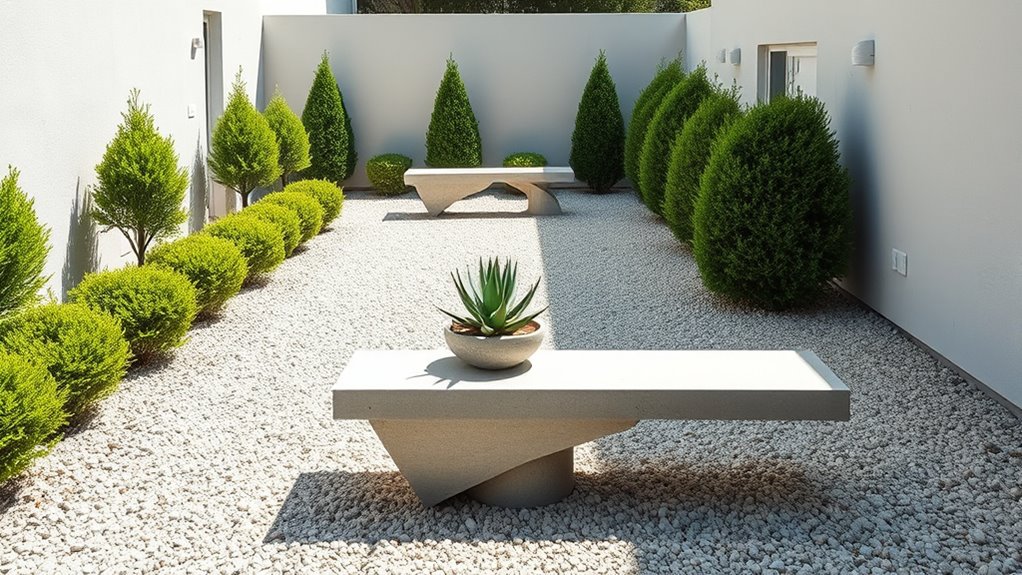
Before diving into planting, it’s essential to determine your garden’s purpose and style. Your garden layout should reflect how you plan to use the space—whether for relaxation, growing vegetables, or creating a peaceful retreat. Clarifying this helps you select appropriate plants and design elements. Incorporating minimalist principles involves choosing simple, functional elements that enhance the space without clutter. Consider how minimalist principles influence your choices, favoring clean lines and uncluttered arrangements. Have your garden tools ready, such as pruning shears, trowels, and rakes, to facilitate a tidy, efficient process. Knowing your goals guides your decisions on plant placement and overall aesthetic. Unplanned weather changes can also lead to comical outcomes, so planning your layout with flexibility in mind can help manage unexpected situations.
Additionally, applying organization techniques can help you maintain a clutter-free garden, making it easier to enjoy and manage over time. By defining your purpose early, you create a cohesive, functional space that aligns with your minimalist vision and makes gardening more enjoyable.
Choose a Limited Color Palette and Plant Selection
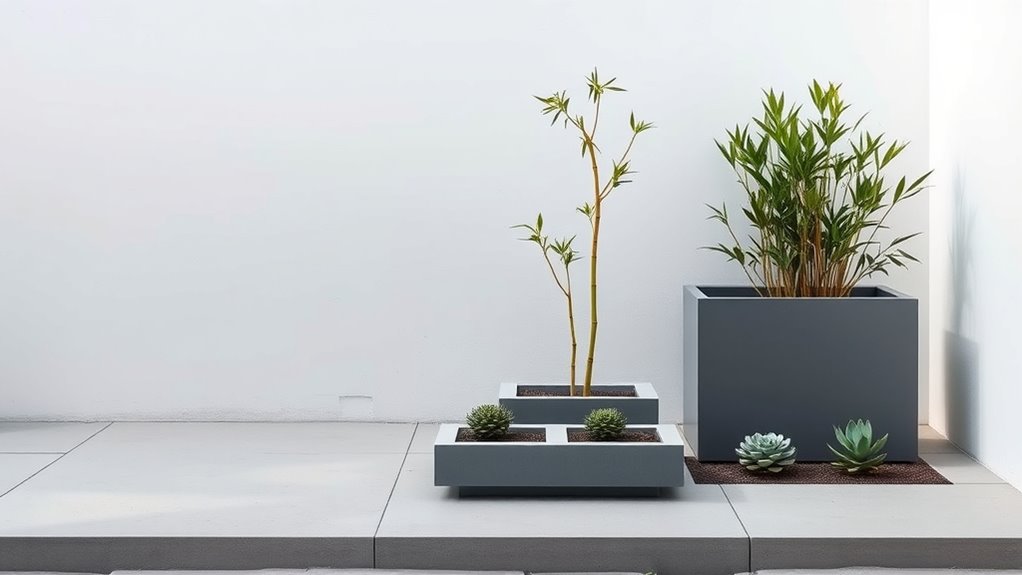
Selecting a limited color palette and plant selection is key to maintaining a minimalist garden’s clean and cohesive look. Opt for a few complementary garden color schemes, such as shades of green, white, or muted earth tones, to create visual harmony. Stick to a handful of plant types to avoid clutter and ensure simplicity. Prioritize plant diversity that offers texture and structure without overwhelming the space—succulents, grasses, or sculptural shrubs work well. Avoid bright, contrasting colors that draw too much attention. Instead, choose subtle, understated hues that enhance the overall calm and serenity. Incorporating natural materials like stone or wood can further emphasize the minimalist aesthetic for a cohesive design. Utilizing high-quality materials ensures durability and a polished appearance that complements the minimalist style. Understanding zodiac compatibility can even inspire plant choices based on elemental harmony, adding a subtle layer of personal connection. Additionally, selecting plants with efficient energy consumption can help create a sustainable and low-maintenance garden environment. Being mindful of growing conditions such as sunlight and soil quality will also contribute to a thriving, low-maintenance space.
Focus on Clean Lines and Simple Layouts
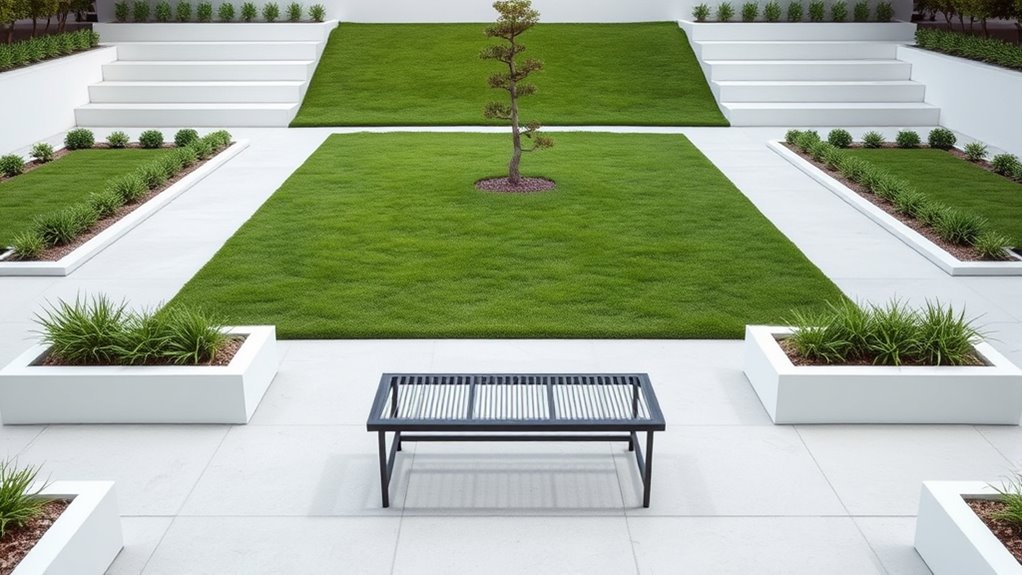
To achieve a minimalist garden’s clean and uncluttered look, focus on creating straightforward, geometric lines and simple layouts. Use clear pathways, symmetrical plant arrangements, and defined borders to establish order. Incorporate automation technologies to streamline garden maintenance and optimize resource use. Select garden furniture with sleek, minimalist designs that complement the overall aesthetic without overwhelming the space. Keep furniture pieces functional and unobtrusive, choosing neutral tones that blend seamlessly into the environment. A simple layout allows for easier pest control, reducing hiding spots for pests and making maintenance more straightforward. Avoid overly complex patterns or cluttered plantings that distract from the clean lines. Utilizing self-watering planters can further simplify watering routines, maintaining consistent moisture levels with minimal effort.
Incorporate Natural Materials and Minimal Decorations
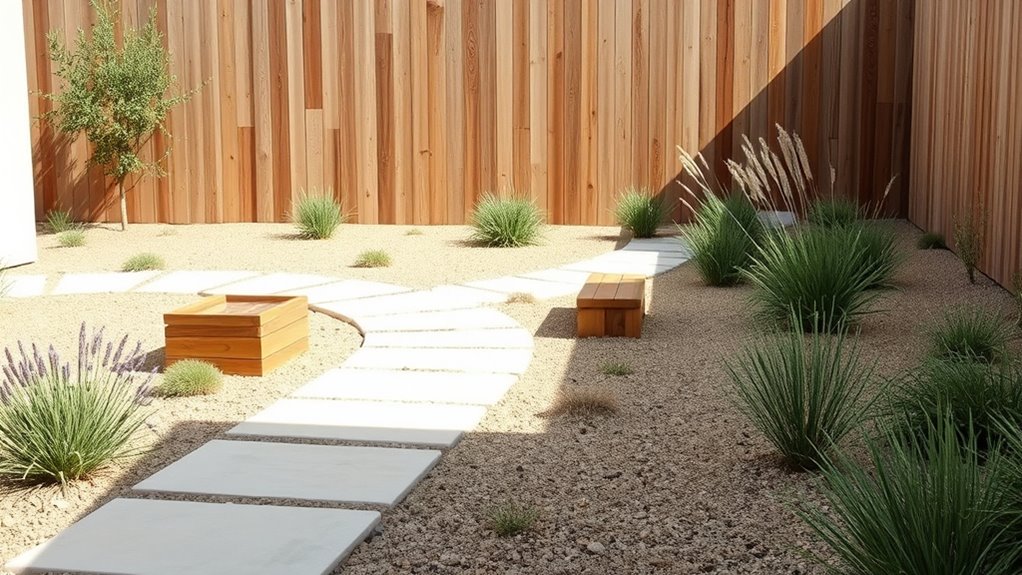
In a minimalist garden, incorporating natural materials and minimal decorations enhances the sense of harmony and authenticity. Choose materials like stone, wood, and gravel to create a grounding, organic feel. These natural elements blend seamlessly with your plants and reinforce the simple aesthetic. Additionally, selecting appropriate garden hours ensures you can enjoy your space during optimal times of the day. When adding decorative accents, opt for subtle garden ornaments that serve as focal points without overwhelming the space. Think of a sleek stone sculpture or a simple ceramic pot. Keep decorations minimal and meaningful, avoiding clutter. The goal is to evoke calm and balance, so select garden ornaments that complement the natural materials and contribute to the overall serenity. Utilizing vetted garden accessories can also help ensure that your decorative choices are both durable and fitting for a minimalist style. Incorporating proper lighting can further highlight your garden’s features while maintaining its understated elegance. Employing sustainable materials in your garden elements can enhance eco-friendliness and long-term durability. Incorporating payment security measures can help safeguard your garden investment against theft or damage. By focusing on quality over quantity, you’ll create a minimalist garden that feels both intentional and peaceful.
Maintain and Evolve Your Garden With Intentional Care
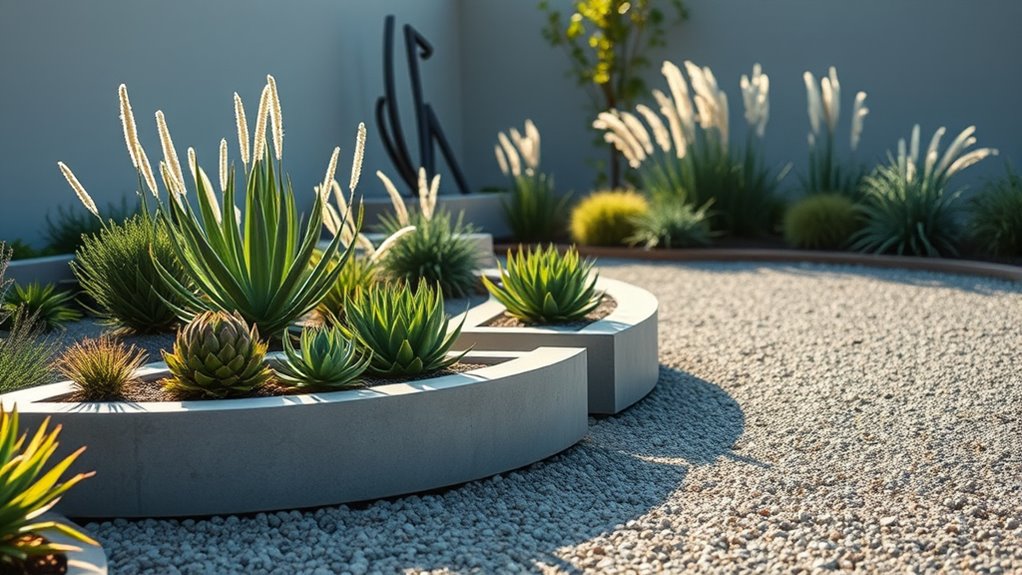
Maintaining a minimalist garden requires intentional care that supports its peaceful and harmonious atmosphere. Regular garden maintenance keeps your space clean and uncluttered, allowing the simplicity to shine. Focus on pruning and removing dead or overgrown plants to maintain clean lines and balance. Seasonal adjustments are vital; adapt your care routines for each time of year. For example, in spring, prepare soil and plant new additions, while in winter, protect sensitive plants from frost. Consistent attention ensures your garden remains tranquil and well-organized. Incorporating water features can also enhance the calming ambiance of your minimalist garden, providing gentle sounds and visual interest without overwhelming the space. Additionally, understanding the importance of contrast ratio can help you choose the right lighting and plant placement to emphasize key features and maintain visual harmony. Regularly monitoring plant health helps prevent pests and diseases, keeping your garden thriving and serene. Incorporating thoughtful landscape design principles can further enhance the overall sense of balance and serenity in your garden.
Frequently Asked Questions
What Are the Best Beginner Plants for a Minimalist Garden?
When choosing beginner plants for a minimalist garden, focus on simple, low-maintenance options. Succulent arrangements are perfect because they require minimal watering and care.
Native plant selection also makes gardening easier, as these plants thrive naturally in your environment.
Opt for clean lines and uncluttered layouts to enhance the minimalist vibe. These choices help you create a serene, stylish garden that’s easy to maintain and visually appealing.
How Can I Maximize Space in a Small Garden?
To maximize space in your small garden, consider vertical planting to make the most of limited ground area. Use wall-mounted planters or trellises for climbing plants.
Incorporate container gardening to easily rearrange and optimize space. Choose multi-purpose containers that double as decorative elements.
What Sustainable Practices Can I Incorporate Into a Minimalist Garden?
You can incorporate sustainable practices into your minimalist garden by using composting methods to enrich your soil naturally, reducing waste and reliance on chemical fertilizers.
Implement water conservation techniques like drip irrigation and mulching to minimize water usage.
Opt for native plants that thrive with less water and maintenance.
These practices help create an eco-friendly, efficient garden that aligns with minimalist principles while supporting environmental health.
How Do I Choose the Right Tools for Minimal Gardening?
Choosing the right tools for minimal gardening might seem simple, but it’s vital for success. Start with essential garden tool selection—think lightweight, multipurpose tools that won’t clutter your space.
Don’t forget pruning essentials; sharp shears make trimming effortless and precise. With the right tools, you’ll work efficiently, keeping your garden neat and sustainable.
Ready to transform your space? With careful selection, your minimalist garden will flourish effortlessly.
Can a Minimalist Garden Be Wildlife-Friendly?
Yes, a minimalist garden can be wildlife-friendly. You can include native plants that attract local pollinators and birds, creating natural food sources.
Incorporate wildlife corridors—simple pathways that connect different areas—to allow animals to move safely through your garden.
Conclusion
Starting a minimalist garden is a rewarding way to create a peaceful outdoor space. Remember, studies show that simple, clutter-free environments can reduce stress and boost well-being. By focusing on purpose, clean lines, and natural materials, you’ll craft a calming retreat that evolves with intentional care. Keep your design intentional, and your garden will remain a beautiful, tranquil haven for years to come. Embrace simplicity, and enjoy the serenity it brings.
